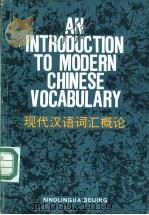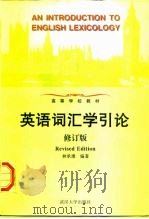《现代英语词汇学引论》
| 作者 | 秦建栋编著 编者 |
|---|---|
| 出版 | 成都:成都科技大学出版社 |
| 参考页数 | 265 |
| 出版时间 | 1997(求助前请核对) 目录预览 |
| ISBN号 | 7561636164 — 求助条款 |
| PDF编号 | 8780168(仅供预览,未存储实际文件) |
| 求助格式 | 扫描PDF(若分多册发行,每次仅能受理1册) |

Chapter One.A General Survey of English Vocabulary1
Ⅰ.Definition of a Word1
Ⅱ.The Growing English Vocabulary3
1.A Historical Review of English Vocabulary3
2.The Recent Growth of English Vocabulary in the 20th Century10
Chapter Two.Morphological Structure and Word-Formation19
Ⅰ.The Concept of Morphemes and the Types of Morphemes19
Ⅱ.The Three Major Processes of Word-Formation22
1.Derivation/Affixation23
2.Conversion36
3.Compounding/Composition43
Ⅲ.The Minor Processes of Word-Formation53
1.Clipping53
2.Blending54
3.Acronymy:Initialisms and Acronyms56
4.Back-Formation60
5.Words from Proper Names63
6.Miscellaneous66
Chapter Three.WordMeaning,Polysemy and Homonymy75
Ⅰ.Motivation75
1.Phonetic Motivation76
2.Morphological Motivation77
3.Semantic Motivation78
Ⅱ.Main Types of Word Meaning79
A.Grammatical Meaning79
B.Lexical Meaning80
1.Denotative Meaning80
2.Connotative Meaning81
3.Social or Stylistic Meaning83
4.Affective Meaning84
5.Reflective Meaning85
6.Collocative Meaning86
7.Contextual Meaning86
Ⅲ.Componential Analysis and Semantic Features87
1.Componential Analysis on the Basis of Semantic Contrast88
2.The Role of Componential Analysis in English Lexical Teaching89
Ⅳ.Polysemy91
Ⅴ.Homonymy94
Chapter Four.Meaning Relations Between Words108
Ⅰ.Synonymy108
Ⅱ.Antonymy116
Ⅲ.Hyponymy123
Ⅳ.Semantic Field126
Chapter Five.Changes in Word Meaning139
Ⅰ.Causes of Changes in Word Meaning139
1.Historical and Social Causes139
2.Psychological Cause140
3.Linguistic Cause142
4.Foreign Influences143
Ⅱ.Four Tendencies in Semantic Change144
1.Extension of Meaning(Generalization)144
2.Restriction of Meaning(Specialization)147
3.Elevation of Meaning(Amelioration)149
4.Degeneration of Meaning(Pejoration)151
Ⅲ.Semantic Changes Resulting from the Figurative Use of Words154
1.Metaphor154
2.Synaesthesia156
3.Metonymy157
4.Synecdoche158
Chapter Six.Meaning and Contexts164
Ⅰ.Types of Contexts164
1.Lexical Context164
2.Grammatical Context166
3.Textual/Discourse Context167
4.Extra-linguistic Context/Context of Situation169
Ⅱ.The Role of Context in Deciding Word Meaning171
1.Eliminating Ambiguities171
2.Specifying Referents and the Range of the Meaning173
3.Conveying Emotional Overtones175
Ⅲ.How to Guess Word Meaning from Context177
1.Lexical Clues178
2.Syntactical Restrictions179
3.Semantic or Logical Connections181
4.The Role of Topic Sentence182
5.The Role of Background Knowledge185
Chapter Seven.English Idioms191
Ⅰ.Sources of English Idioms191
1.Sources191
2.Classification of the Sources194
Ⅱ.Classification of English Idioms204
1.Noun Phrases204
2.Verbal Phrases207
3.Adjectival Idiomatic Expressions210
4.Adverbial and Prepositional Idiomatic Expressions211
5.Proverbs213
Ⅲ.Beware"Translation Traps"215
Ⅳ.Syntactic,Structural and Stylistic Features of Idioms221
1.Syntactic Function221
2.Structural Features225
3.Stylistic Features227
Chapter Eight.American English235
Ⅰ.Growth of American English235
Ⅱ.Characteristics of American English238
1.Conservatism and Innovation in American English238
2.Heterogeneity241
3.Relative Uniformity in Speech243
4.Verbose and Plain Style in Writing245
Ⅲ.Differences Between American and British English247
1.Differences in Pronunciation247
2.Differences in Spelling250
3.Differences in Grammar and usage253
4.Differences in Vocabulary257
1997《现代英语词汇学引论》由于是年代较久的资料都绝版了,几乎不可能购买到实物。如果大家为了学习确实需要,可向博主求助其电子版PDF文件(由秦建栋编著 1997 成都:成都科技大学出版社 出版的版本) 。对合法合规的求助,我会当即受理并将下载地址发送给你。
高度相关资料
-

- 现代英语词汇学
- 1983 上海:上海外语教育出版社
-

- 现代汉语词汇
- 1985
-

- 现代英语词汇学概论
- 1986
-

- 现代汉语词汇概论
- 1988 北京:华语教学出版社
-

- 现代汉语词汇
- 1959
-

- 英语词汇学引论
- 1960 北京:商务印书馆
-

- 现代英语词汇与词汇教学
- 1989 广州:广东高等教育出版社
-

- 现代英语词汇学
- 1985 合肥:安徽教育出版社
-

- 汉语词汇学引论
- 1992 北京:商务印书馆
-

- 现代俄语词汇学
- 1958 北京:商务印书馆
-

- 现代英语词汇活用辞典
- 1993 太原:山西高校联合出版社
-

- 现代英汉医学词汇
- 1989 北京:人民卫生出版社
-

- 现代汉语词汇系统论
- 1999 北京:北京大学出版社
-

- 现代汉语词汇
- 1985 北京:北京大学出版社
-

- 英语词汇学引论
- 1987 武汉:武汉大学出版社
提示:百度云已更名为百度网盘(百度盘),天翼云盘、微盘下载地址……暂未提供。➥ PDF文字可复制化或转WORD